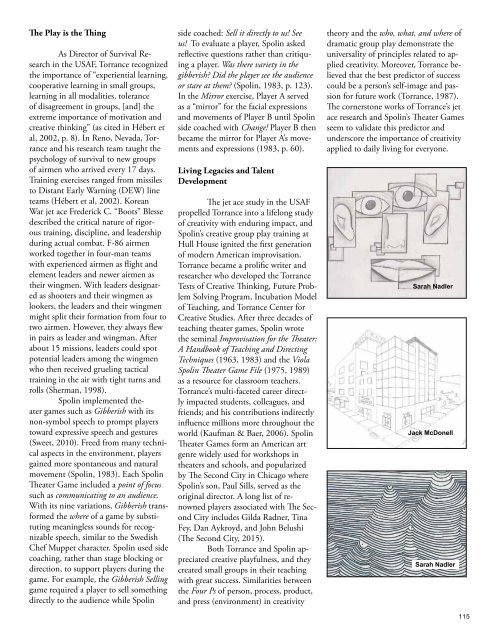Torrance Journal for Applied Creativity
TorranceJournal_V1
TorranceJournal_V1
Create successful ePaper yourself
Turn your PDF publications into a flip-book with our unique Google optimized e-Paper software.
The Play is the Thing<br />
As Director of Survival Research<br />
in the USAF, <strong>Torrance</strong> recognized<br />
the importance of “experiential learning,<br />
cooperative learning in small groups,<br />
learning in all modalities, tolerance<br />
of disagreement in groups, [and] the<br />
extreme importance of motivation and<br />
creative thinking” (as cited in Hébert et<br />
al, 2002, p. 8). In Reno, Nevada, <strong>Torrance</strong><br />
and his research team taught the<br />
psychology of survival to new groups<br />
of airmen who arrived every 17 days.<br />
Training exercises ranged from missiles<br />
to Distant Early Warning (DEW) line<br />
teams (Hébert et al, 2002). Korean<br />
War jet ace Frederick C. “Boots” Blesse<br />
described the critical nature of rigorous<br />
training, discipline, and leadership<br />
during actual combat. F-86 airmen<br />
worked together in four-man teams<br />
with experienced airmen as flight and<br />
element leaders and newer airmen as<br />
their wingmen. With leaders designated<br />
as shooters and their wingmen as<br />
lookers, the leaders and their wingmen<br />
might split their <strong>for</strong>mation from four to<br />
two airmen. However, they always flew<br />
in pairs as leader and wingman. After<br />
about 15 missions, leaders could spot<br />
potential leaders among the wingmen<br />
who then received grueling tactical<br />
training in the air with tight turns and<br />
rolls (Sherman, 1998).<br />
Spolin implemented theater<br />
games such as Gibberish with its<br />
non-symbol speech to prompt players<br />
toward expressive speech and gestures<br />
(Sweet, 2010). Freed from many technical<br />
aspects in the environment, players<br />
gained more spontaneous and natural<br />
movement (Spolin, 1983). Each Spolin<br />
Theater Game included a point of focus<br />
such as communicating to an audience.<br />
With its nine variations, Gibberish trans<strong>for</strong>med<br />
the where of a game by substituting<br />
meaningless sounds <strong>for</strong> recognizable<br />
speech, similar to the Swedish<br />
Chef Muppet character. Spolin used side<br />
coaching, rather than stage blocking or<br />
direction, to support players during the<br />
game. For example, the Gibberish Selling<br />
game required a player to sell something<br />
directly to the audience while Spolin<br />
side coached: Sell it directly to us! See<br />
us! To evaluate a player, Spolin asked<br />
reflective questions rather than critiquing<br />
a player. Was there variety in the<br />
gibberish? Did the player see the audience<br />
or stare at them? (Spolin, 1983, p. 123).<br />
In the Mirror exercise, Player A served<br />
as a “mirror” <strong>for</strong> the facial expressions<br />
and movements of Player B until Spolin<br />
side coached with Change! Player B then<br />
became the mirror <strong>for</strong> Player A’s movements<br />
and expressions (1983, p. 60).<br />
Living Legacies and Talent<br />
Development<br />
The jet ace study in the USAF<br />
propelled <strong>Torrance</strong> into a lifelong study<br />
of creativity with enduring impact, and<br />
Spolin’s creative group play training at<br />
Hull House ignited the first generation<br />
of modern American improvisation.<br />
<strong>Torrance</strong> became a prolific writer and<br />
researcher who developed the <strong>Torrance</strong><br />
Tests of Creative Thinking, Future Problem<br />
Solving Program, Incubation Model<br />
of Teaching, and <strong>Torrance</strong> Center <strong>for</strong><br />
Creative Studies. After three decades of<br />
teaching theater games, Spolin wrote<br />
the seminal Improvisation <strong>for</strong> the Theater:<br />
A Handbook of Teaching and Directing<br />
Techniques (1963, 1983) and the Viola<br />
Spolin Theater Game File (1975, 1989)<br />
as a resource <strong>for</strong> classroom teachers.<br />
<strong>Torrance</strong>’s multi-faceted career directly<br />
impacted students, colleagues, and<br />
friends; and his contributions indirectly<br />
influence millions more throughout the<br />
world (Kaufman & Baer, 2006). Spolin<br />
Theater Games <strong>for</strong>m an American art<br />
genre widely used <strong>for</strong> workshops in<br />
theaters and schools, and popularized<br />
by The Second City in Chicago where<br />
Spolin’s son, Paul Sills, served as the<br />
original director. A long list of renowned<br />
players associated with The Second<br />
City includes Gilda Radner, Tina<br />
Fey, Dan Aykroyd, and John Belushi<br />
(The Second City, 2015).<br />
Both <strong>Torrance</strong> and Spolin appreciated<br />
creative playfulness, and they<br />
created small groups in their teaching<br />
with great success. Similarities between<br />
the Four Ps of person, process, product,<br />
and press (environment) in creativity<br />
theory and the who, what, and where of<br />
dramatic group play demonstrate the<br />
universality of principles related to applied<br />
creativity. Moreover, <strong>Torrance</strong> believed<br />
that the best predictor of success<br />
could be a person’s self-image and passion<br />
<strong>for</strong> future work (<strong>Torrance</strong>, 1987).<br />
The cornerstone works of <strong>Torrance</strong>’s jet<br />
ace research and Spolin’s Theater Games<br />
seem to validate this predictor and<br />
underscore the importance of creativity<br />
applied to daily living <strong>for</strong> everyone.<br />
Sarah Nadler<br />
Jack McDonell<br />
Sarah Nadler<br />
115


